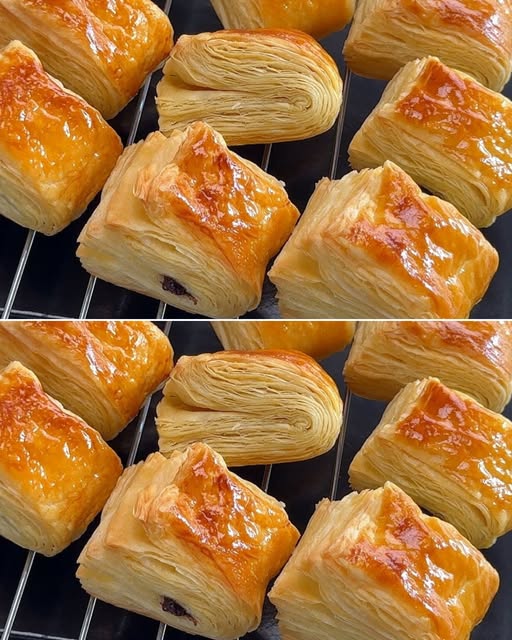The art of making puff pastry dates back to 17th century France, where it was perfected by master pastry chef Claude Lorrain. This time-honored technique of repeatedly folding butter into dough creates the signature flaky layers that define this elegant pastry. When baked, these layers puff up to create a light, crispy, and buttery pastry that serves as the foundation for numerous classic French desserts and savory dishes.
Ingredients
For the Détrempe (Basic Dough)
- 250g (2 cups) bread flour or Italian 00 flour
- 30g (2 tablespoons) unsalted butter, room temperature
- 2-3g (½ teaspoon) salt (omit if using salted butter)
- 125ml (½ cup) water, room temperature
For the Beurrage (Butter Block)
- 120g (½ cup) unsalted butter, room temperature
For the Egg Wash
- 1 egg yolk
- 15ml (1 tablespoon) water
Time Requirements
- Initial Dough Preparation: 15 minutes
- First Rest: 15 minutes
- Second Rest: 10 minutes
- Lamination Process: 45 minutes
- Freezing Intervals: 35 minutes
- Baking Time: 30 minutes
- Total Time: 2 hours 30 minutes
Step-by-Step Instructions
Preparing the Détrempe
- Mix Initial Dough
- Combine flour and salt in a large bowl
- Cut room temperature butter into small pieces
- Add water gradually while mixing
- Knead until smooth and elastic (approximately 8-10 minutes)
- Rest dough covered for 15 minutes
- First Division
- Cut dough into two equal portions (204g each)
- Shape into rectangles
- Wrap in plastic
- Rest for additional 10 minutes
Lamination Process
- First Roll
- Roll each portion into 30x30cm square
- Spread 60g softened butter evenly across surface
- Ensure butter is pliable but not melted
- Creating Layers
- Execute 9 letter folds to achieve 18 layers
- Keep edges aligned during folding
- Freeze for 20 minutes between every third fold
- Roll to 24x35cm
- Complete final fold for 72 layers
- Freeze 15 minutes before shaping
Final Preparation and Baking
- Shaping
- Roll dough to 5-6mm thickness
- Cut into desired shapes
- Place on parchment-lined baking sheets
- Baking
- Preheat oven to 200°C (400°F)
- Brush with egg wash
- Bake at 200°C for 20 minutes
- Reduce temperature to 160°C (320°F)
- Continue baking 10 minutes until golden
Nutritional Information
Per 100g serving:
- Calories: 350
- Protein: 5g
- Carbohydrates: 35g
- Fat: 20g
- Saturated Fat: 12g
- Fiber: 1g
Professional Tips
- Temperature Control
- Maintain dough and butter at similar consistency
- Work in cool room temperature (18-22°C)
- Avoid overworking dough to prevent butter melting
- Technique Refinement
- Keep edges straight during rolling
- Brush excess flour from surface between folds
- Maintain rectangular shape throughout process
- Quality Assurance
- Use high-protein flour for better structure
- Choose European-style butter (82% fat content)
- Ensure precise measurements for optimal results
Variations and Substitutions
- Flour Options
- All-purpose flour (reduce water by 10ml)
- Pastry flour (increase butter by 10g)
- Whole wheat blend (use 70% white, 30% whole wheat)
- Butter Alternatives
- Plant-based butter (reduce quantity by 10%)
- Margarine (adjust freezing time)
- Vegan blocks (select high-fat versions)
Frequently Asked Questions
Q: Why did my layers not puff properly?
A: Common causes include butter too warm during folding, uneven rolling, or insufficient resting time between folds.
Q: Can I make this ahead of time?
A: Yes, the dough can be frozen for up to 3 months after final lamination.
Q: How do I prevent the butter from breaking through the dough?
A: Ensure consistent temperature and gentle, even pressure when rolling.
Q: What’s the best way to cut shapes without damaging layers?
A: Use sharp, straight-down cuts without dragging the knife.
Storage and Make-Ahead Tips
Short-Term Storage
- Refrigerate wrapped dough up to 3 days
- Keep shaped, unbaked pastries covered and chilled
- Baked items store at room temperature 1-2 days
Long-Term Storage
- Freeze laminated dough up to 3 months
- Wrap tightly in plastic and foil
- Thaw overnight in refrigerator before use
Make-Ahead Strategies
- Complete lamination process day before baking
- Shape and freeze raw pastries
- Bake directly from frozen, adding 5-7 minutes to baking time
This classic French technique requires patience and precision but rewards with incomparably flaky, buttery pastries. Whether creating croissants, palmiers, or savory applications, mastering puff pastry opens a world of culinary possibilities.
